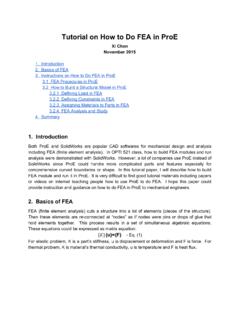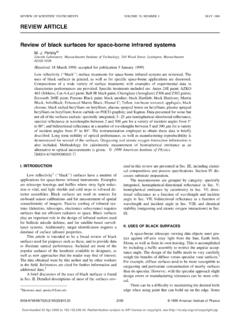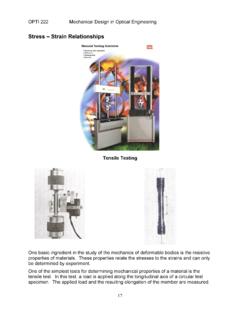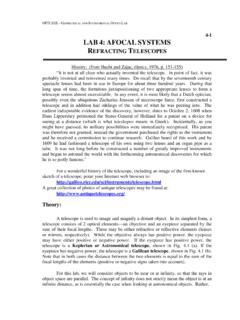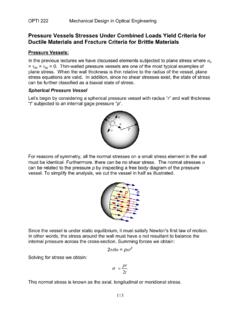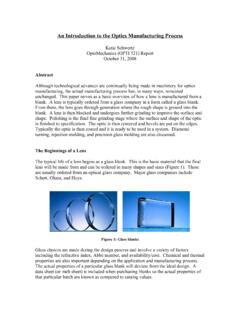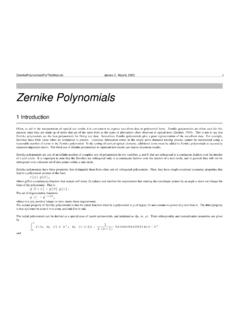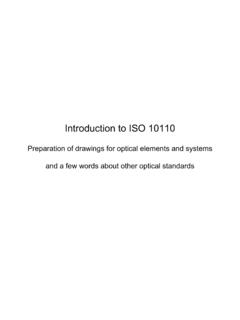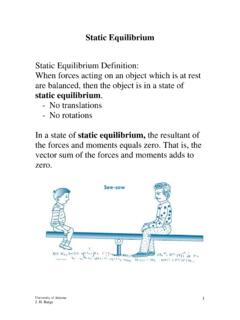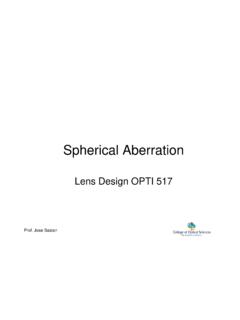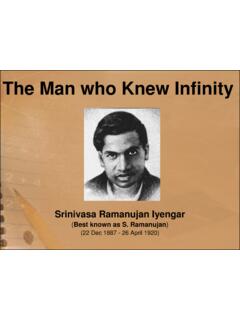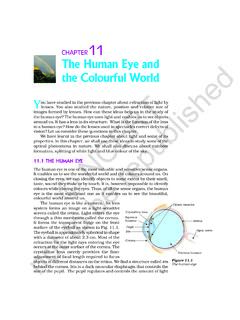Transcription of Tutorial of Telecentric Lens
1 Tutorial of Telecentric Lens Haosheng Hu College of Optical Sciences University of Arizona December 6, 2016 Introduction: Nowadays, high accuracy and performance of critical to many machine vision system, a method that use Telecentric lens allows highest possible accuracy to be obtained. This Tutorial introduced the concept and set up for the object-space telecenric system and image-space Telecentric system and advantages of Telecentric lens that can impact the system performance. Also, some recent advanced product of Telecentric lens or systems in optical field are provided. Concept of Telecentric Lens: The definition of Telecentric lens is that a compound lens with entrance pupil or exit pupil at infinity distance, which can provide orthographic view of the subject.
2 Because of the infinity entrance pupil or exit pupil, chief ray, which pass through the center of aperture stop will parallel to the optical axis in front of or behind the optical system. Commonly, there are two kinds of Telecentric , one is objective-space Telecentric , another one is image-space Telecentric . Object-space Telecentric System: For the object-space Telecentric system, the entrance pupil of this system at infinity . The easiest way to make an object-space Telecentric system is placing the stop at the rear focal plane and maintain the entrance pupil at infinity . Normally, the image plane or detector is placed, which means nominal object position is in focus. The concept drawing of object-space Telecentric system is shown in Fig 1.
3 Fig 1. Concept Drawing of Object-space Telecentric System When the object is displaced from the nominal object position, the location and size of the resulting image changes. The chief ray does not change, and the ray bundle remains centered on the chief ray. On the detector, a blur will be recorded, but the height of the centroid of this blur does not change from the original image height. This situation is shown in Fig 2. Fig 2. Object Displacement in Object-space Telecentric System In an object-space Telecentric system, the measured image size is independent of the object location. The measured image will be blurred, but the centroid height of this blur does not change. The magnification of the recorded image of the object is fixed, and the correct object size can be determined.
4 This situation is shown in Fig 3. Fig 3. Image Measurement in Object-space Telecentric System Object-space Telecentric systems are almost always used at close finite conjugates. The maximum object size is limited to approximately the radius of the objective lens due to vignetting considerations. As the nominal object distance increases, the image and the detector move closer to the stop position. The required lens diameter increases. At some point a practical limit is reached, and the lens will become the system stop the system will no longer be Telecentric . We can compare the figure below to understand it. Fig 4. Finite Conjugates of Object-space Telecentric System Image-space Telecentric System: For the image-space Telecentric system, the exit pupil of this system at infinity .
5 The easiest way to make an image-space Telecentric system is placing the stop aperture at the front focal plane and maintain the exit pupil at infinity . In image-space Telecentric system, defocus of the image plane or detector will not change the image height or magnification, which means the image-space Telecentric system has changeless magnification. The concept drawing of image-space Telecentric system is shown in Fig 5. Fig 5. Concept Drawing of Image-space Telecentric System Determine the F-number and Working F-number of Object/Image-space Telecentric System: For object-space Telecentric system, entrance pupil is at infinity and size is infinite, which means the F-number of object-space Telecentric system is not determined.
6 For image-space Telecentric system, shown in Fig 6, the working F-number is defined as: Note that the approximation f/#w (1-m) f/# cannot be used in this situation, as the system does not satisfy the requirement needed for this approximation that DEP DXP. Fig 6. Determine the F-number of Image-space Telecentric System Double Telecentric : Besides the object-space Telecentric and image-space Telecentric system, we can use afocal system made a double Telecentric system. The system stop of double Telecentric system is located at the common focal point, so the chief ray is still parallel to the optical axis in object and image space. The entrance pupil and exit pupil are both located at infinity , and both size are infinite.
7 All double Telecentric system must be afocal system. Since the ray bundle is centered on the chief ray, this condition guarantees that height of the blur forming the image is independent of axial object shifts or image plane shifts. Fig 7. Concept of Double Telecentric System The Advantages of Telecentric System: (1) Zero Angle Field of View to Minimize the Paraxial Error Commonly, we use conventional lenses in our daily life, which have angular field of view. For the conventional lenses image, if the distance between the lens and object is increased, the magnification of this system will decrease. Our human eyes have the same function, and it contributes the depth perception. Also, this angular field of view in conventional lenses will introduce paraxial error that decrease the accuracy of the image.
8 A typical angular field of view conventional lens is shown in Fig 8. Fig 8. Typical Angular Field of View Conventional Lens According to the previous introduction of Telecentric lenses, Telecentric system has constant field of view, which can benefits and constraints for gauging application. As result, Telecentric system s magnification does not change in respect to depth, it is the first and primary advantage of Telecentric system. A typical zero angle field of view Telecentric lens is shown in Fig 9. Fig 9. Typical Zero Angle Field of View Telecentric Lens A comparison result between the photo taken by fixed focal length lens (Angular field of view conventional lens) and the photo taken by zero angle field of view Telecentric lens is shown in figure below: Fig 10.
9 Cube Set Up to Take Photos Fig 11. Photo Taken by Fixed Focal Length Lens (Angular field of view conventional lens) Fig 12. Photo Taken by Zero Angle Field of View Telecentric Lens This photo comparison shows the difference image function between angular field of view conventional lens and zero angle field of view Telecentric lens clearly. The photo taken by zero angle field of view Telecentric lens is hard to tell which cube is in front of the other, but for the photo taken by fixed focal length lens is so obvious the bigger cube is in front of the smaller one. This comparison described the importance of minimizing the parallel error, because in real life, automated inspection tasks are imaging objects that move through the field of view of an imaging system, and the position of parts is rarely perfectly repeatable.
10 If the working distance is not identical for each object that the lens is imaging, the measurement of each object will vary due to the magnification shift. A machine vision system that outputs different results based on a magnification calibration error is a non-reliable solution and cannot be used when high precision is necessary. Telecentric Lenses eliminate the concern about measurement errors that would otherwise occur due to factors such as a vibrating conveyor or inexact part locations. There are more figures to verify the conclusion above. Fig 13. Object Set Up Fig 14. Photos Taken by Conventional Lens (left) and Telecentric Lens (right) (2) Telecentric Lens Has Large Depth of Field The depth of field is controlled by the wavelength and F-number of the lens, which means Telecentric lens has larger depth of field than conventional lens due to the symmetrical blurring on either side of best foucus.
